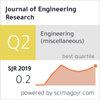农业废弃物作为重金属可持续吸附剂的研究进展
IF 0.9
4区 工程技术
Q3 ENGINEERING, MULTIDISCIPLINARY
引用次数: 0
摘要
低成本吸附剂已成为替代工业活性炭在水处理中应用的良好选择。由于它们具有从废水中吸附污染物的能力,并且它们的使用最大限度地减少了环境中的废物。随着钢铁、铜等材料的加工和生产的增加,重金属已成为主要的水污染物。因此,对可作为廉价吸附剂的农业废弃物进行了利用研究。本文研究了四种主要的农业废弃物,即坚果壳/核、壳/壳/种皮、农林果皮等,并将其作为吸附剂进行了比较,以去除或减少先前研究中描述的几种废水杂质。结果表明,果壳/果核(如绿椰子单组分)对铅和镉具有较好的吸附能力,而壳/壳/种皮(如大豆壳和改性扁豆壳)对铜和铅具有较好的吸附能力。农林业果皮的利用,包括化学改性的橙皮和橙皮,在去除镉和镍方面显示出良好的结果。此外,成本分析显示了与利用这些废料有关的估计费用的差异。农林用果皮的估计费用略低,而坚果壳和壳/壳的估计费用相当。未来的研究应着重于吸附能力的优化、实际应用的探索以及潜在大规模实施的经济可行性评估。本文章由计算机程序翻译,如有差异,请以英文原文为准。
Utilization of agriculture waste materials as sustainable adsorbents for heavy metal removal: A comprehensive review
Low cost-adsorbent has been a good candidate as an alternative for commercial activated carbon in the application of water treatment. As they possess the capability of adsorbing contaminants, from wastewater and their use minimizes waste in the environment. Heavy metals have been a primary water pollutant since the increase in processing and production of several materials such as steel, copper, etc. Therefore, research has been conducted on the utilization of agricultural wastes which may serve as low-price adsorbents. In this paper, four main categories of agricultural waste materials, namely nut shells/stones, hulls/husks/seed coats, agroforestry peels, and others were investigated and compared as adsorbents to remove or minimize several wastewater impurities described in previous research. The results showed that the Nut shells/stones, such as green coconut single component, demonstrate effective adsorption capacities for lead and cadmium, while hulls/husks/seed coats, including soya bean hulls and modified Lentil husk, exhibit remarkable adsorption of copper and lead. The utilization of agroforestry peels, including chemically modified orange peel and orange peel, shows promising results in the removal of cadmium and nickel. Furthermore, the cost analysis shows variations in the estimated expenses associated with the utilization of these waste materials. Agroforestry peels demonstrate slightly lower estimated expenses, while Nut shells and hulls/husks exhibit comparable cost estimates. Future research should focus on the optimization of adsorption capacities, the exploration of practical applications, and the assessment of economic feasibility for potential large-scale implementation.
求助全文
通过发布文献求助,成功后即可免费获取论文全文。
去求助
来源期刊

Journal of Engineering Research
ENGINEERING, MULTIDISCIPLINARY-
CiteScore
1.60
自引率
10.00%
发文量
181
审稿时长
20 weeks
期刊介绍:
Journal of Engineering Research (JER) is a international, peer reviewed journal which publishes full length original research papers, reviews, case studies related to all areas of Engineering such as: Civil, Mechanical, Industrial, Electrical, Computer, Chemical, Petroleum, Aerospace, Architectural, Biomedical, Coastal, Environmental, Marine & Ocean, Metallurgical & Materials, software, Surveying, Systems and Manufacturing Engineering. In particular, JER focuses on innovative approaches and methods that contribute to solving the environmental and manufacturing problems, which exist primarily in the Arabian Gulf region and the Middle East countries. Kuwait University used to publish the Journal "Kuwait Journal of Science and Engineering" (ISSN: 1024-8684), which included Science and Engineering articles since 1974. In 2011 the decision was taken to split KJSE into two independent Journals - "Journal of Engineering Research "(JER) and "Kuwait Journal of Science" (KJS).
 求助内容:
求助内容: 应助结果提醒方式:
应助结果提醒方式:


